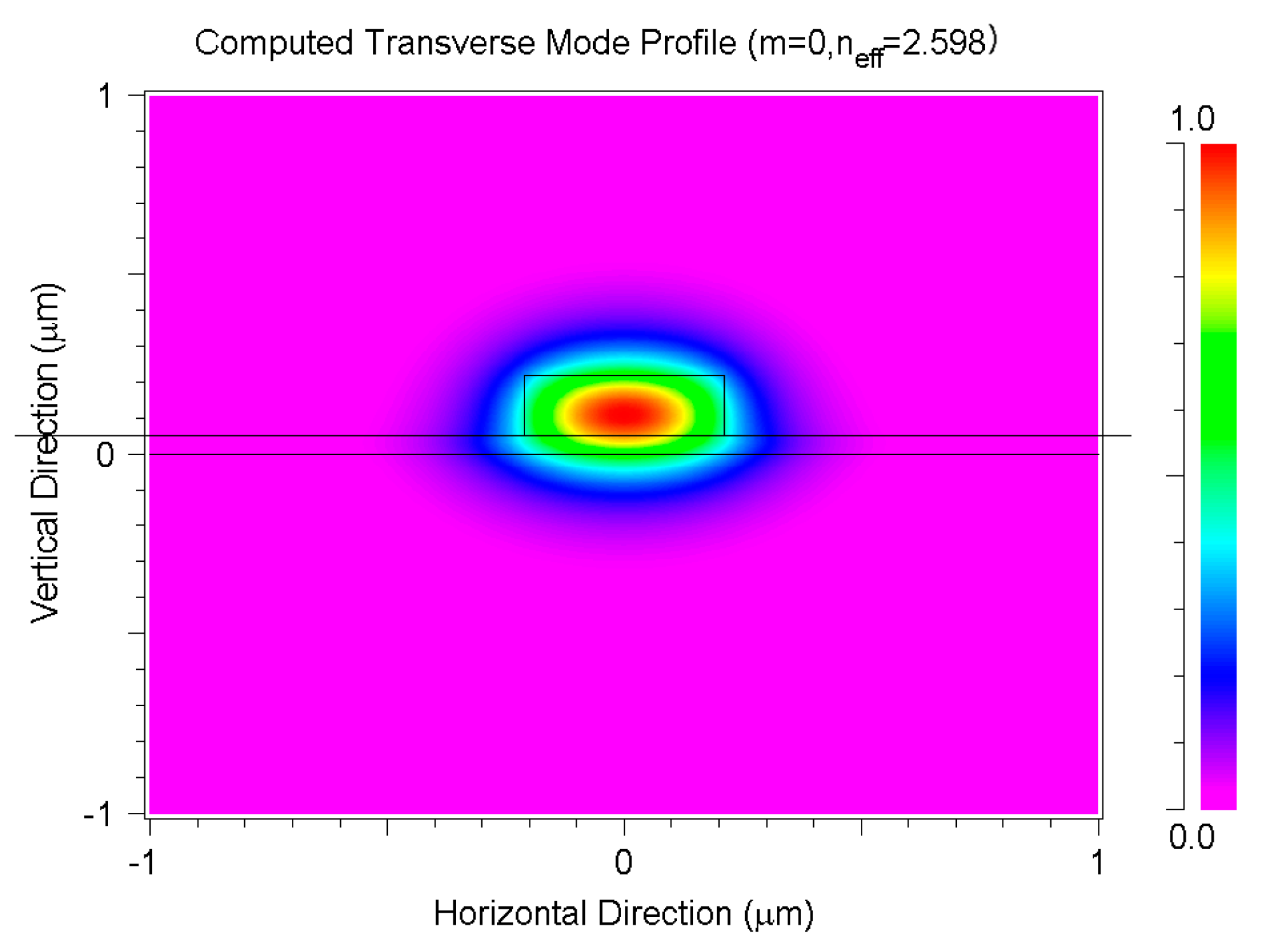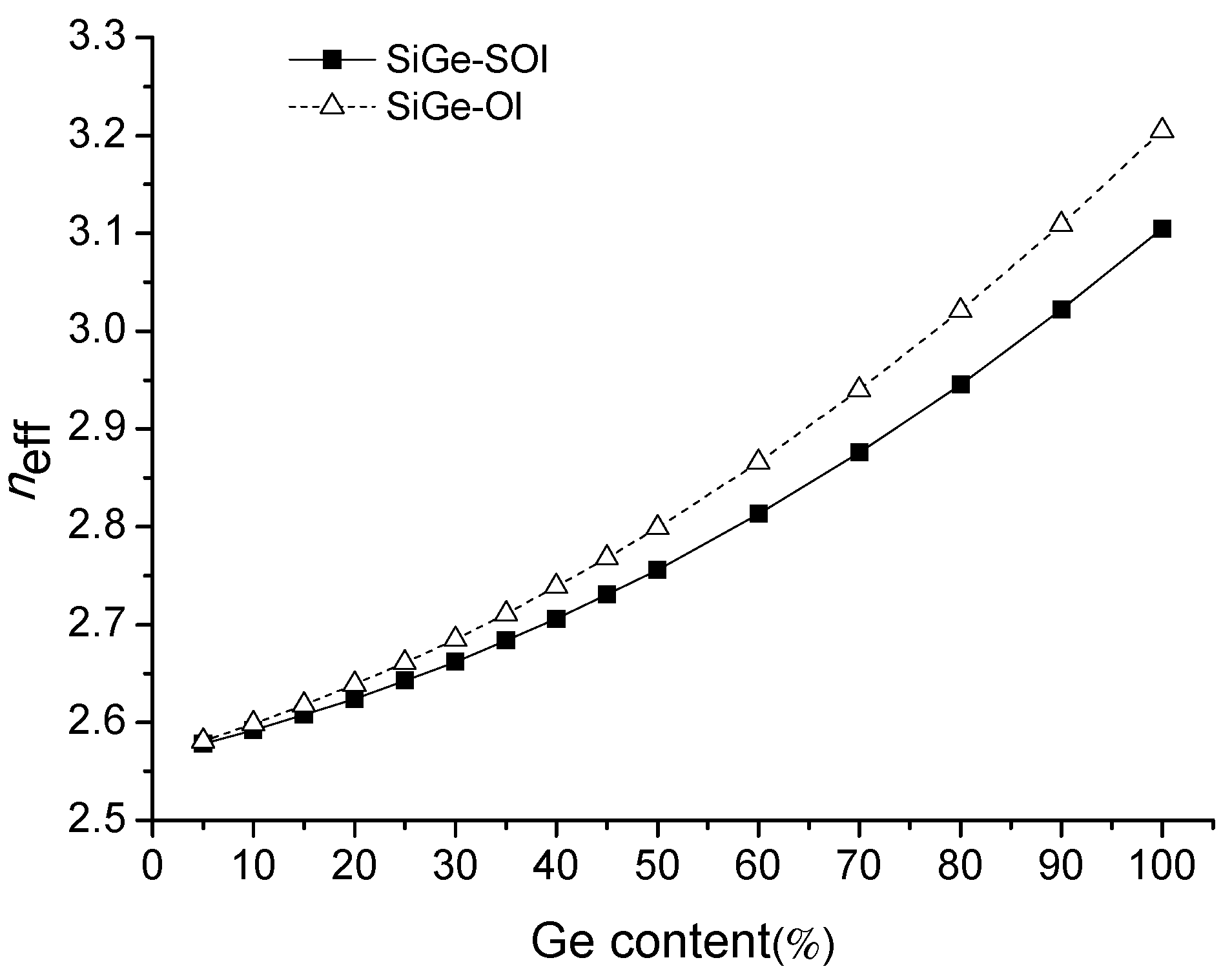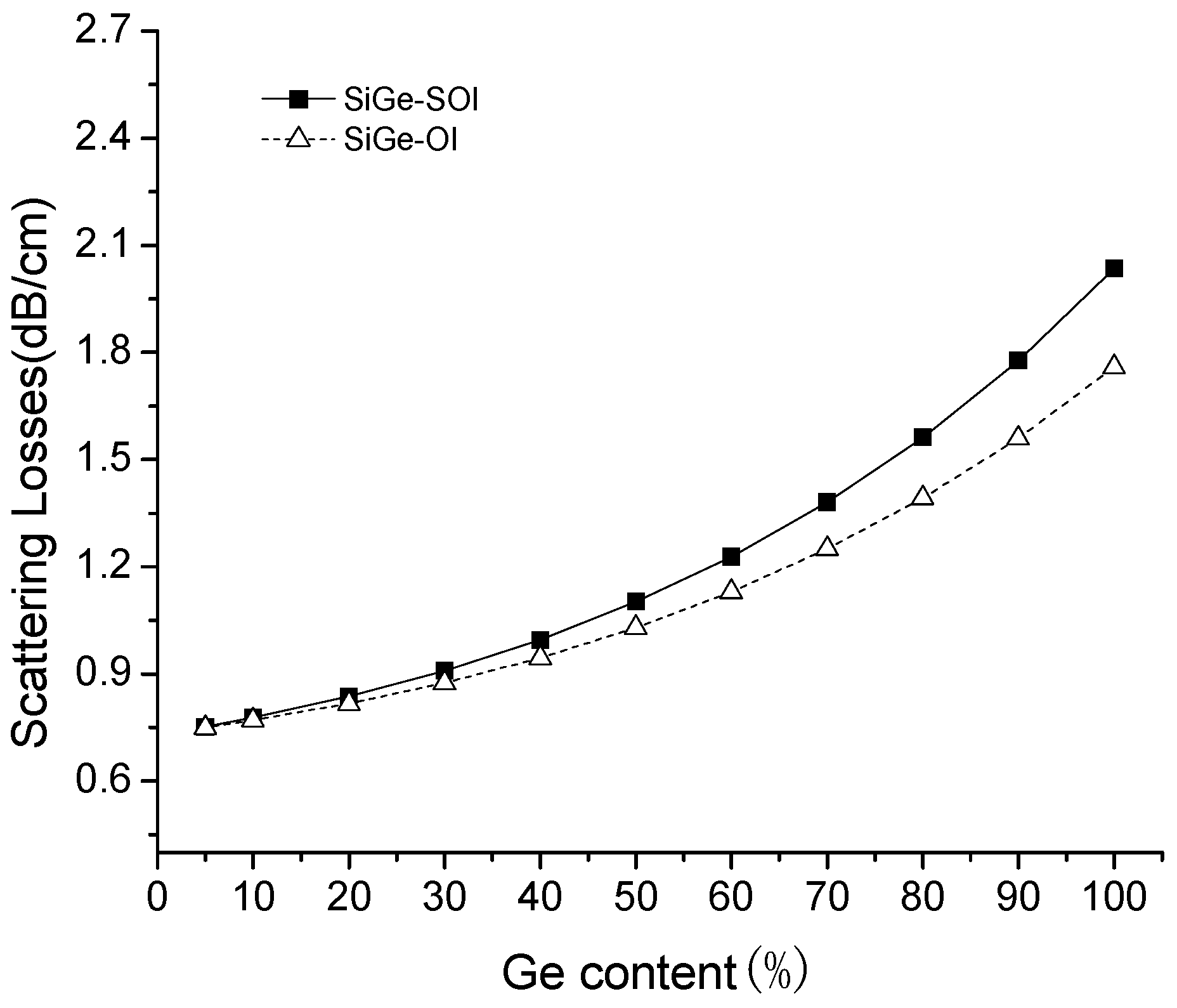Research into Two Photonic-Integrated Waveguides Based on SiGe Material
Abstract
:1. Introduction
2. Mechanism and Manufactures
- Pretreatment of SOI substrate, mainly cleaning and dusting the surface of silicon wafer;
- Thinning the SOI substrate;
- Growing the SiGe layer on the top of the silicon membrane by UHV/CVD method;
- Depositing the SiO2 layer by PECVD, and using the generated silica as the etching mask layer of SiGe;
- Applying photoresist and using mask for lithography;
- Putting the lithographic film into the developer for development, transfering the image from mask to photoresist and making the film hard;
- Etching the silicon dioxide mask layer with photoresist as the mask, transferring the graphics from the photoresist layer to the silicon dioxide mask layer;
- Using the silicon dioxide mask layer as the mask to etch the SiGe layer, transfering the graphics from the silicon dioxide mask layer to the SiGe layer, and completing the fabrication of the waveguide structure;
- Removing photoresist, silicon dioxide mask layer and scratch.
3. Results and Discussion
4. Conclusions
Author Contributions
Funding
Acknowledgments
Conflicts of Interest
References
- Nedeljkovic, M.; Littlejohns, C.G.; Khokhar, A.Z.; Banakar, M.; Cao, W.; Penades, J.S.; Tran, D.T.; Gardes, F.Y.; Thomson, D.J.; Reed, G.T.; et al. Silicon-on-insulator free-carrier injection modulators for the mid-infrared. Opt. Lett. 2019, 44, 915–918. [Google Scholar] [CrossRef] [PubMed]
- Li, S.; Tarr, N.G.; Ye, W.N. JFET integration using a foundry SOI photonics platform. Appl. Sci. 2019, 9, 3964. [Google Scholar] [CrossRef] [Green Version]
- Kim, T.; Wang, B.; Wang, C.; Kohen, D.A.; Hwang, J.W.; Shin, J.C.; Kang, S.; Michel, J. Metalorganic chemical vapor deposition-regrown Ga-rich InGaP films on SiGe virtual substrates for Si-based III-V optoelectronic device applications. J. Vac. Sci. Technol. A 2017, 35, 31507. [Google Scholar] [CrossRef]
- Cartoixa, X.; Palummo, M.; Hauge, H.; Bakkers, E.; Rurali, R. Optical Emission in Hexagonal SiGe Nanowires. Nano Lett. 2017, 17, 4753–4758. [Google Scholar] [CrossRef]
- Akie, M.; Fujisawa, T.; Sato, T.; Arai, M.; Saitoh, K. GeSn/SiGeSn multiple-quantum-well electroabsorption modulator with taper coupler for mid-infrared Ge-on-Si platform. IEEE J. Sel. Top. Quantum Electron. 2018, 24, 3400208. [Google Scholar] [CrossRef]
- Soref, R.A.; Namavar, F.; Lorenzo, J.P. Optical waveguiding in an epitaxial layer of silicon—Germaniumn grown on silicon. Proc. SPIE 1989, 1177, 175–184. [Google Scholar]
- People, R.; Bean, J.C. Calculation of critical layer thickness versus lattice mismatch for Si1-xGex/Si strained-layer hetero structures. Appl. Phys. Lett. 1985, 47, 322. [Google Scholar] [CrossRef]
- Lim, P.H.; Cai, J.; Ishikawa, Y.; Wada, K. C-band electro modulation in silicon germanium ring and linear devices. Appl. Phys. Lett. 2010, 97, 115–118. [Google Scholar] [CrossRef]
- Deng, S.; Huang, Z.R.; McDonald, J.F. Design of High Efficiency Multi-GHz SiGe HBT Electro-Optic Modulator. Opt. Express 2009, 17, 13425–13438. [Google Scholar] [CrossRef]
- Brun, M.; Labeye, P.; Grand, G.; Hartmann, J.; Boulila, F.; Carras, M.; Nicoletti, S. Low loss SiGe graded index waveguides for mid-IR applications. Opt. Express 2014, 22, 508–518. [Google Scholar] [CrossRef]
- Douix, M.; Perez-Galacho, D.; Charlet, I.; Baudot, C.; Acosta-Alba, P.; Kerdilès, S.; Euvrard, C.; Grosse, P.; Planchot, J.; Blanc, R.; et al. SiGe-enhanced Si capacitive modulator integration in a 300 mm silicon photonics platform for low power consumption. Opt. Express 2019, 27, 17701–17707. [Google Scholar] [CrossRef] [PubMed]
- Tzintzarov, G.N.; Ildefonso, A.; Patrick, S.G.; Frounchi, M.; Nergui, D.; Rao, S.G.; Teng, J.; Campbell, J.; Khachatrian, A.; Buchner, S.P.; et al. Electronic-to-Photonic Single-Event Transient Propagation in a Segmented Mach-Zehnder Modulator in a Si/SiGe Integrated Photonics Platform. IEEE Trans. Nucl. Sci. 2020, 67, 260–267. [Google Scholar] [CrossRef]
- Splett, A.; Zinke, T.; Petermann, K.; Kasper, E.; Kibbel, H.; Herzog, H.-J.; Presting, H. Integration of Waveguides and Photodetectors in SiGe for 1.3 μm Operation. IEEE Photonics Technol. Lett. 1994, 6, 59–61. [Google Scholar] [CrossRef]
- Rouifed, M.; Marris-Morini, D.; Chaisakul, P.; Frigerio, J.; Isella, G.; Chrastina, D.; Edmond, S.; Le Roux, X.; Coudevylle, J.; Bouville, D.; et al. Advances toward Ge/SiGe quantum-well waveguide modulators at 1.3 μm. IEEE J. Sel. Top. Quantum Electron. 2014, 20, 3400207. [Google Scholar] [CrossRef]
- Sekiguchi, S.; Kurahashi, T.; Zhu, L.; Kawaguchi, K.; Morito, K. Compact and low power operation optical switch using silicon-germanium/silicon hetero-structure waveguide. Opt. Express 2012, 20, 8949–8958. [Google Scholar] [CrossRef]
- Vakarin, V.; Chaisakul, P.; Frigerio, J.; Ballabio, A.; le Roux, X.; Coudevylle, J.; Bouville, D.; Perez-Galacho, D.; Vivien, L.; Isella, G.; et al. Sharp bends and Mach-Zehnder interferometer based on Ge-rich-SiGe waveguides on SiGe graded buffer. Opt. Express 2015, 23, 30821–30826. [Google Scholar] [CrossRef] [Green Version]
- Ettabib, M.A.; Lacava, C.; Liu, Z.; Bogris, A.; Kapsalis, A.; Brun, M.; Labeye, P.; Nicoletti, S.; Syvridis, D.; Richardson, D.J.; et al. Wavelength conversion of complex modulation formats in a compact SiGe waveguide. Opt. Express 2017, 25, 3252–3258. [Google Scholar] [CrossRef] [Green Version]
- Li, B.; Li, G.; Liu, E.; Jiang, Z.; Pei, C.; Wang, X. 1.55 μm reflection-type optical waveguide switch based on SiGe/Si plasma dispersion effect. Appl. Phys. Lett. 1999, 75, 1–3. [Google Scholar] [CrossRef]
- Serna1, S.; Vakarin, V.; Ramirez, J.M.; Frigerio, J.; Ballabio, A.; Vivien, L.; Isella, G.; Cassan, E.; Dubreuil, N.; Marris-Morini, D. Nonlinear properties of Ge-rich SiGe waveguides. In Proceedings of the 2017 CLEO Pacific Rim Conference, Singapore, 29 July–3 August 2017. [Google Scholar]
- Gallacher, K.; Ortolani, M.; Rew, K.; Ciano, C.; Baldassarre, L.; Virgilio, M.; Scalari, G.; Faist, J.; di Gaspare, L.; de Seta, M.; et al. Design and simulation of losses in Ge/SiGe terahertz quantum cascade laser waveguides. Opt. Express 2020, 28, 4786–4800. [Google Scholar] [CrossRef]
- Liu, Q.; Ramírez, J.M.; Vakarin, V.; Perez-Galacho, D.; Alonso-Ramos, C.; Vivien, L.; Marris-Morini, D.; Frigerio, J.; Ballabio, A.; Isella, G. Design of Mid-IR integrated cavity based on Ge-rich graded SiGe waveguides. In Proceedings of the Photonics North, Ottawa, ON, Canada, 6–8 June 2017. [Google Scholar]
- Ramírez, J.M.; Vakarin, V.; Chaisaku, P.; Frigerio, J.; Ballabio, A.; Gilles, C.; Chrastina, D.; Liu, Q.; Maisons, G.; le Roux, X.; et al. Ge-rich SiGe waveguides for mid-infrared photonics. In Proceedings of the SPIE Photonics West, San Francisco, CA, USA, 31 January–2 February 2017. [Google Scholar]
- Lamy, M.; Finot, C.; Fatome, J.; Brun, M.; Labeye, P.; Nicolleti, S.; Bogris, A.; Syvridis, D.; Ettabib, M.; Richardson, D.J.; et al. 10 GBit/s Optical Transmissions at 1.98 μm in cm-long SiGe Waveguides. Electron. Lett. 2017, 53, 1213–1214. [Google Scholar] [CrossRef] [Green Version]
- Liu, Q.; Ramírez, J.M.; Vakarin, V.; Frigerio, J.; Ballabio, A.; Vivien, L.; Alonso-Ramos, C.; Isella, G.; Marris-Morini, D. Mid-IR integrated cavity based on Ge-rich graded SiGe waveguides with lateral Bragg grating. In Proceedings of the High-Brightness Sources and Light-Driven Interactions Congress, Strasbourg, France, 26–28 March 2018. [Google Scholar]
- Liu, Q.; Ramírez, J.M.; Vakarin, V.; le Roux, X.; Ballabio, A.; Frigerio, J.; Chrastina, D.; Isella, G.; Bouville, D.; Vivien, L.; et al. Mid-infrared sensing between 5.2 and 6.6 μm wavelengths using Ge-rich SiGe waveguides. Opt. Mater. Express 2018, 8, 1305–1312. [Google Scholar] [CrossRef] [Green Version]
- Serna, S.; Vakarin, V.; Ramirez, J.M.; le Roux, X.; Frigerio, J.; Ballabio, A.; Vivien, L.; Isella, G.; Cassan, E.; Dubreuil, N.; et al. Third Order Nonlinear Optical Properties of Ge-Rich SiGe Waveguides. In Proceedings of the IEEE Group IV Photonics, Berlin, Germany, 26–28 August 2017. [Google Scholar]
- Keisuke, A.; Hiroki, N.; Shohei, M.; Utsuyama, N.; Yamanaka, J.; Hara, K.O.; Usami, N.; Nakagawa, K. Growth of strained Si/relaxed SiGe heterostructures on Si(110) substrates using solid-source molecular beam epitaxy. Semicond. Sci. Technol. 2017, 32, 114002. [Google Scholar]
- Youngmo, K.; Sungyeol, Y.; Hong, K.D.; Sohn, H. Influence of Si precursor type on the surface roughening of SiGe epitaxial layers deposited by ultrahigh vacuum chemical vapor deposition method. J. Vac. Sci. Technol. 2017, 35, 041403. [Google Scholar]
- An, Z.; Wu, Y.; Zhang, M.; Di, Z.; Lin, C.; Fu, R.K.Y.; Chen, P.; Chu, P.K.; Cheung, W.Y.; Wong, S.P. Relaxed Silicon-Germanium-on-insulator Substrates by Oxygen Implantation into Preudomorphic Silicon Germanium/Silicon Heterostructure. Appl. Phys. Lett. 2003, 82, 2452–2454. [Google Scholar] [CrossRef]
- Chang, Z.; Carrie, M.T.; Leitz, C.W.; Taraschi, G.; Pitera, A.; Lee, M.L.; Langdo, T.A.; Hoyt, J.L.; Antoniadis, D.A.; Fitzgerald, E.A. SiGe-on-insulator (SGOI): Substrate PrePaartion and MOSFET fabrication of electron mobility evaluation. In Proceedings of the 2001 IEEE Intemational SOI Conference, Durango, CO, USA, 1–4 October 2001. [Google Scholar]
- Heidmann, S.; Ulliac, G.; Courjal, N. Characterization and control of the electro-optic phase dispersion in lithium niobate modulators for wide spectral band interferometry applications in the mid-infrared. Appl. Opt. 2017, 56, 4153–4157. [Google Scholar] [CrossRef]
- Tezuka, T.; Nakaharai, S.; Moriyama, Y.; Hirashita, N.; Toyoda, E.; Numata, T.; Irisawa, T.; Usuda, K.; Sugiyama, N.; Mizuno, T.; et al. Strained SOI/SGOI dual-channel CMOS technology based on the Ge condensation technique. Semicond. Sci. Technol. 2006, 22, 93–98. [Google Scholar] [CrossRef]
- Di, Z.; Paul, K.C.; Zhang, M.; Liu, W.; Song, Z.; Lin, C. Germanium Movement Meehanism in SiGe-on-Insulator Fabrieated by Modified Ge Condensation. J. Appl. Phys. 2005, 97, 064504. [Google Scholar] [CrossRef] [Green Version]
- Zhao, C.; Gao, Y. Semiconductor Silicon-Based Materials and the Optical Waveguides, 1st ed.; Electronic Industry Press: Beijing, China, 1997; pp. 232–233. [Google Scholar]
- Feng, S.; Gao, Y.; Yang, Y.; Yuchun, F. Mode analysis and structure parameters optimization of a novel SiGe-OI rib optical waveguides. Chin. J. Semicond. 2009, 30, 084008. [Google Scholar]
- Ronald Hadley, G. Transparent boundary condition for the beam propagation method. IEEE J. Quantum Electron. 1992, 82, 363–370. [Google Scholar] [CrossRef] [Green Version]
- Braunstein, R.; Moore, A.R.; Herman, F. Intrinsic optical absorption in germanium-silicon alloys. Phys. Rev. 1958, 109, 695–710. [Google Scholar] [CrossRef]
- Liu, A.; Jones, R.; Liao, L.; Rubio, D.S.; Rubin, D.; Cohen, O.; Nicolaescu, R.; Paniccia, M. A high-speed silicon optical modulator based on a semiconductor capacitor. Nature 2004, 427, 615–618. [Google Scholar] [CrossRef] [PubMed]
- Payne, F.P.; Lacey, J.P.R. A theoretical analysis of scattering loss from planar optical waveguides. Opt. Quantum Electron. 1994, 26, 977–986. [Google Scholar] [CrossRef]
- Ladouceur, F.; Love, J.D.; Senden, T.J. Measurement of surface-roughness in buried channel wave-guides. Electron. Lett. 1992, 28, 1321–1322. [Google Scholar] [CrossRef]
- Lee, K.K.; Lim, D.R.; Luan, H.C.; Agrawal, A.; Foresi, J.; Kimerling, L.C. Effect of size and roughness on light transmission in a Si_SiO2 waveguide: Experiments and model. Appl. Phys. Lett. 2000, 77, 1617–1619. [Google Scholar] [CrossRef]
- Feng, S.; Li, L.; Xue, B. Research on a Micro-Nano Si/SiGe/Si double Heterojunction electro-optic modulation structure. Adv. Condens. Matter Phys. 2018, 5, 054201. [Google Scholar] [CrossRef] [Green Version]







| Ge | H/nm | h/nm | W/nm |
|---|---|---|---|
| 5% | 220 | 50 | 400 |
| 420 | |||
| 440 | |||
| 460 | |||
| 480 | |||
| 500 | |||
| 560 | |||
| 600 |
© 2020 by the authors. Licensee MDPI, Basel, Switzerland. This article is an open access article distributed under the terms and conditions of the Creative Commons Attribution (CC BY) license (http://creativecommons.org/licenses/by/4.0/).
Share and Cite
Feng, S.; Xue, B. Research into Two Photonic-Integrated Waveguides Based on SiGe Material. Materials 2020, 13, 1877. https://doi.org/10.3390/ma13081877
Feng S, Xue B. Research into Two Photonic-Integrated Waveguides Based on SiGe Material. Materials. 2020; 13(8):1877. https://doi.org/10.3390/ma13081877
Chicago/Turabian StyleFeng, Song, and Bin Xue. 2020. "Research into Two Photonic-Integrated Waveguides Based on SiGe Material" Materials 13, no. 8: 1877. https://doi.org/10.3390/ma13081877




